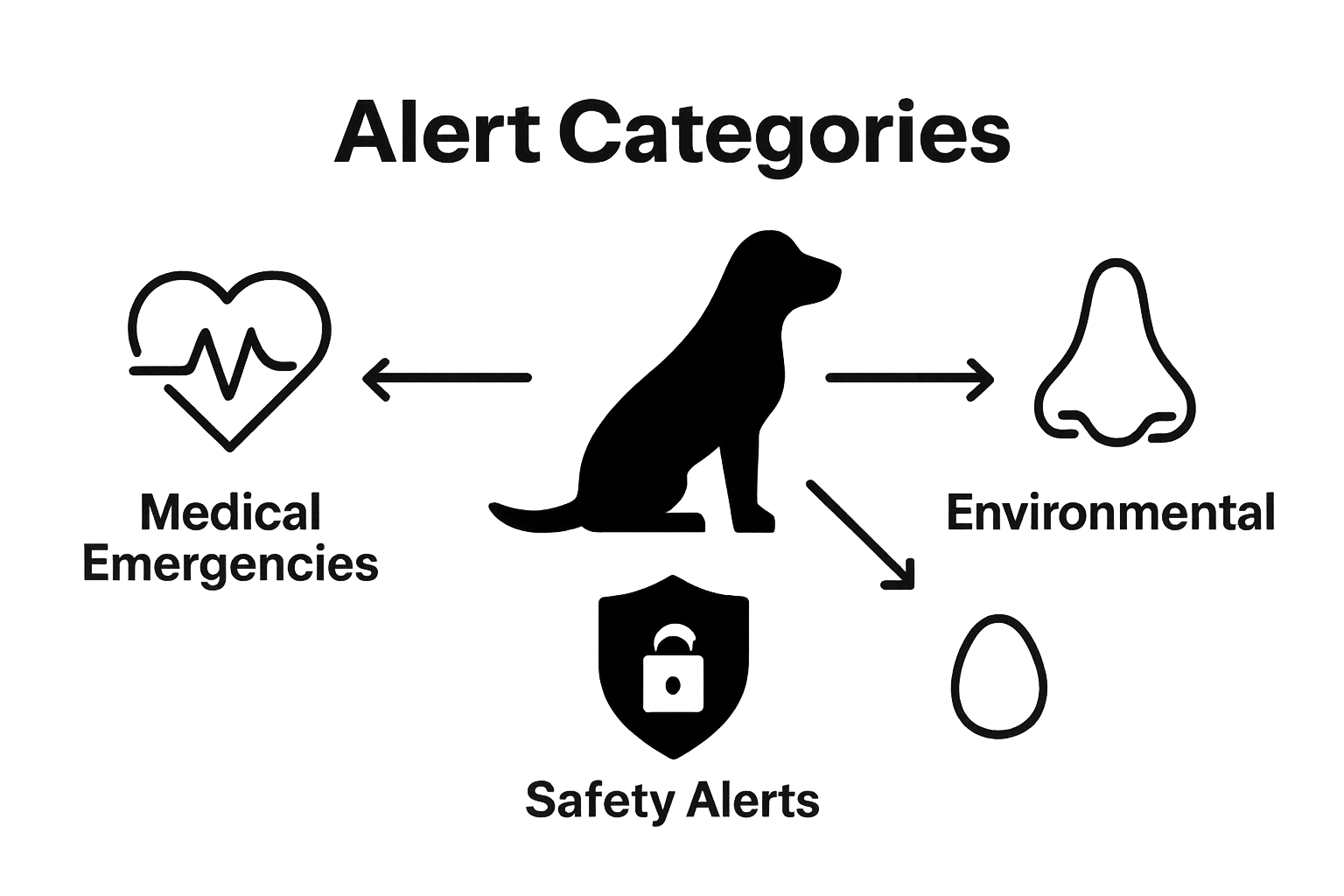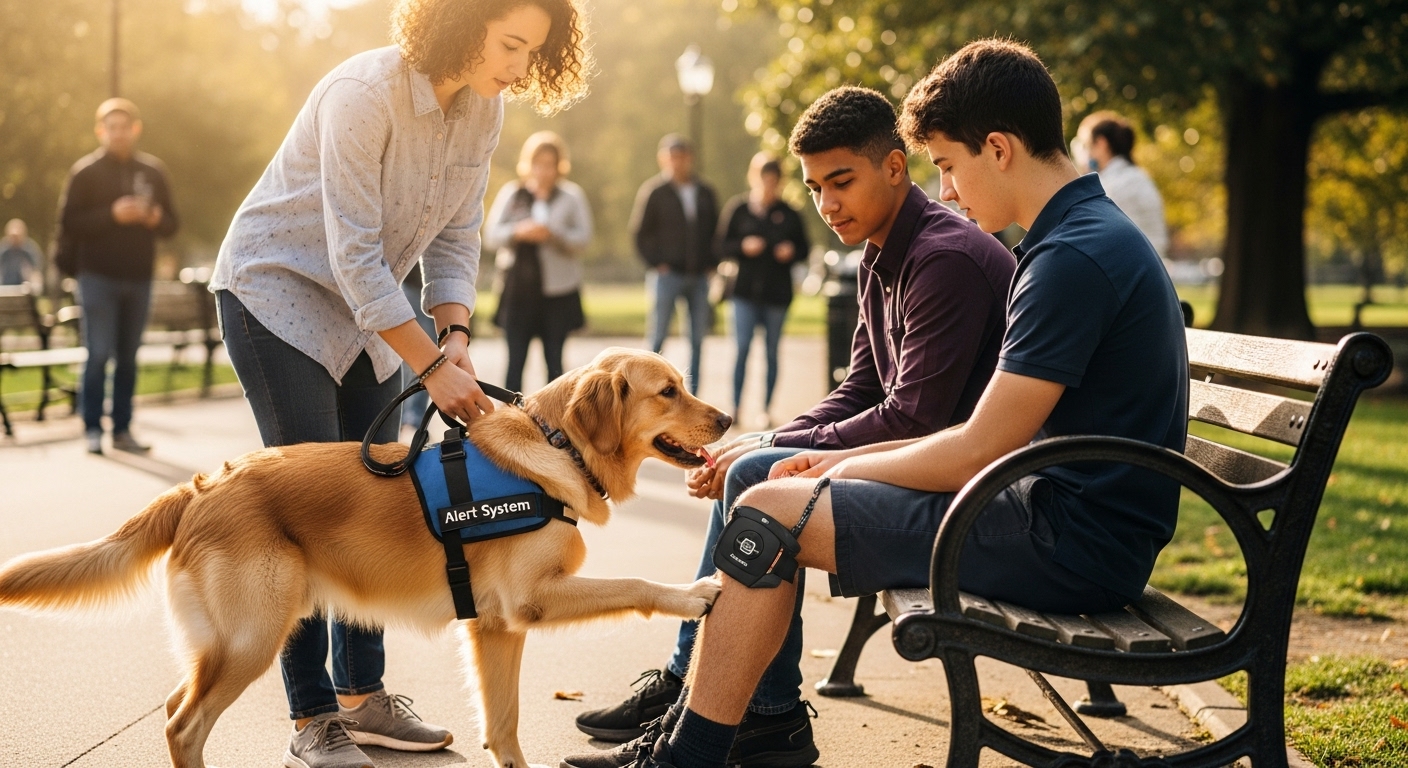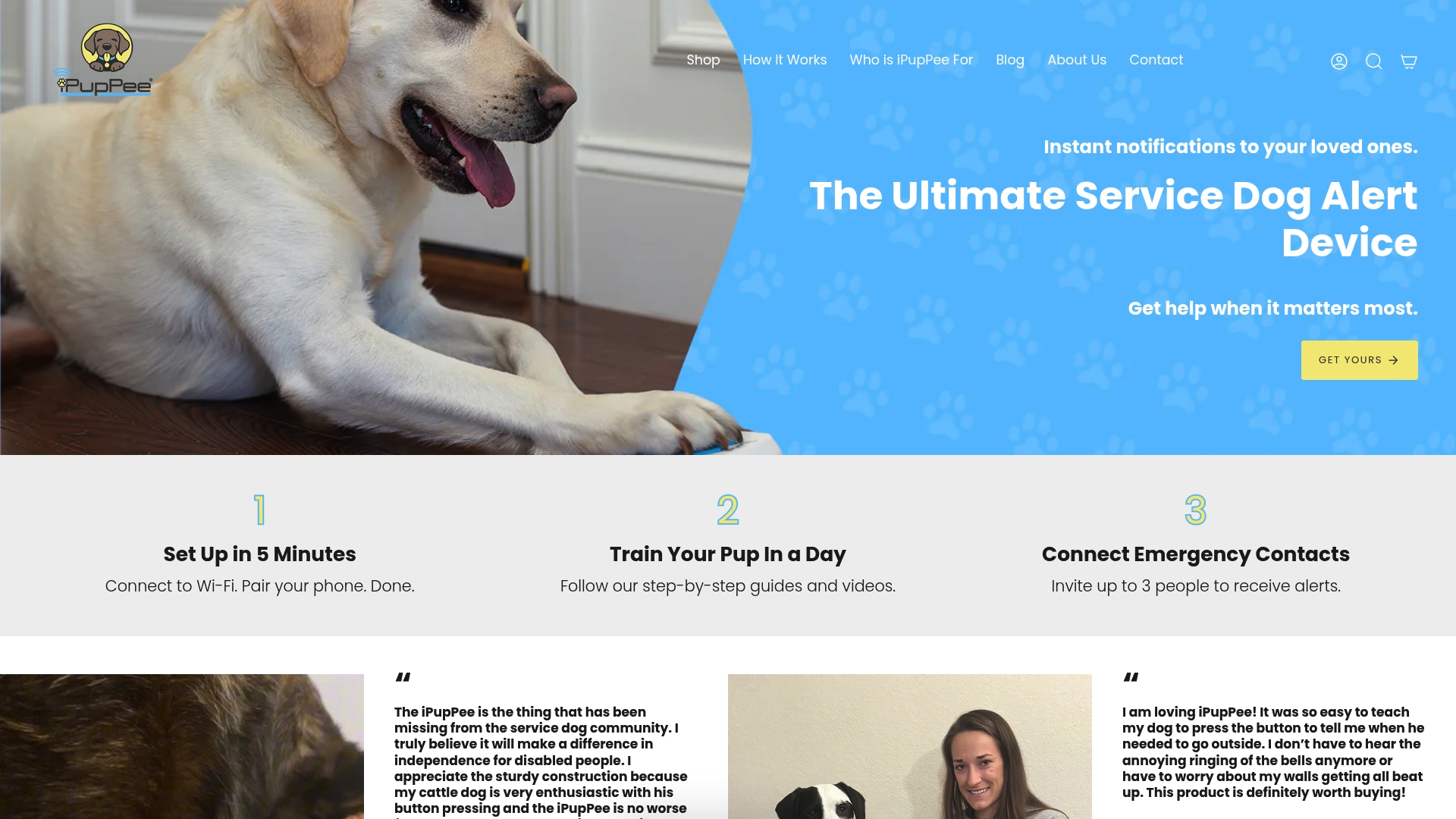Dog alerts do so much more than fetch your slippers or bark at the door. Recent studies show that trained dogs can detect multiple medical emergencies and target their alerts to more than one person at once. That sounds impressive, but the real surprise is how these simple behaviors are actually intentional signals—turning everyday pets into lifesaving partners in ways most people never realize.
Table of Contents
- What Are Dog Alerts And Their Purpose?
- The Importance Of Dog Alerts For Safety
- How Dogs Detect And Alert To Various Situations
- Key Concepts Behind Training Alert Dogs
- Real-World Applications Of Dog Alerts In Daily Life
Quick Summary
| Takeaway | Explanation |
|---|---|
| Dog alerts serve critical safety roles. | Trained dogs can signal emergencies, providing safety for individuals with medical conditions or disabilities. |
| Dogs use various communication methods. | Canines employ signals such as nudges, barks, or body postures to alert their handlers effectively. |
| Training is essential for effective alerts. | Dogs must undergo specialized training to discern conditions and respond consistently, ensuring reliable communication. |
| Alerts can prevent medical emergencies. | Early detection of health issues, such as seizures or blood sugar changes, can significantly reduce health risks for individuals. |
| Dog alerts support personal independence. | These alerts empower individuals, especially those with disabilities, to navigate environments with confidence and security. |
What are Dog Alerts and Their Purpose?
Dog alerts represent a sophisticated communication mechanism where trained canines signal specific conditions or potential issues to their handlers or owners. These alerts are not random behaviors but strategic, purposeful interactions designed to convey critical information quickly and effectively.
Understanding the Core Concept of Dog Alerts
At its essence, a dog alert is a deliberate behavioral response where a dog communicates a specific message through predetermined signals. According to research from the Medical Alert Dog Study, these alerts can span multiple health conditions and even target multiple individuals, demonstrating remarkable communication capabilities.
The primary purposes of dog alerts include:
- Signaling medical emergencies or health status changes
- Providing safety warnings for individuals with disabilities
- Detecting environmental hazards or potential threats
- Supporting individuals with sensory processing challenges
Types of Dog Alert Mechanisms
Dog alerts can manifest through various communication methods. Some dogs use physical contact like nudging or pawing, while others might bark, stand in a specific stance, or even use specialized alert devices designed for enhanced communication. The specific alert mechanism depends on the dog’s training, the handler’s needs, and the intended communication purpose.
The following table compares major types of dog alert mechanisms and their typical features, helping readers quickly understand the differences at a glance.
| Alert Mechanism | Description | Typical Use Cases |
|---|---|---|
| Nudging or Pawing | Dog physically touches handler with nose or paw | Medical emergencies, general alerts |
| Barking | Dog uses vocalization to attract immediate attention | Environmental hazards, intruders |
| Specific Body Posture | Dog assumes a unique stance to signal an issue | Health concerns, sensory alerts |
| Guiding/Leading | Dog physically leads handler away from danger | Environmental risks, emergencies |
| Specialized Devices | Dog interacts with a device (e.g., button) for alerts | Enhanced communication, remote alerts |

Understanding how dog alerts work requires recognizing that these are learned behaviors developed through targeted training. Professional trainers carefully condition dogs to recognize specific triggers and respond with consistent, identifiable signals that their handlers can readily interpret. This communication system transforms dogs from mere companions into active partners in managing health, safety, and daily living challenges.
This table provides a summary of key purposes behind dog alerts, illustrating how these trained signals address varying needs in medical, safety, and support contexts.
| Dog Alert Purpose | Explanation |
|---|---|
| Medical Emergency Signaling | Notifies handlers about health status changes or imminent crises |
| Environmental Hazard Warning | Detects dangers like gas leaks or fires |
| Personal Security | Alerts to unauthorized intruders or potential threats |
| Sensory Support | Assists individuals with sensory processing challenges |
| Independence Enhancement | Empowers individuals to act confidently and safely in daily situations |
The Importance of Dog Alerts for Safety
Dog alerts play a critical role in enhancing personal safety across multiple domains, transforming canine companions into proactive guardians and lifesaving partners. These sophisticated communication systems enable dogs to detect potential risks and communicate urgent information that could prevent dangerous situations.
Medical Emergency Protection
In medical contexts, dog alerts are potentially life-saving interventions. According to research published in Frontiers in Veterinary Science, trained dogs can provide early warnings for critical health events like seizures, sudden blood sugar changes, or impending cardiac incidents. These alerts give individuals crucial moments to seek help or take preventive actions, significantly reducing potential health risks.
Key safety benefits of dog alerts include:
- Immediate notification of medical emergencies
- Rapid response to potential life-threatening conditions
- Enhanced independence for individuals with chronic health challenges
- Reduced anxiety for both handlers and caregivers
Environmental and Personal Security
Beyond medical contexts, dog alerts extend to broader safety domains. Dogs can detect environmental hazards such as gas leaks, fire risks, or unauthorized intruders. For individuals with disabilities or sensory processing challenges, these alerts provide an additional layer of security. Learn more about advanced alert device options for enhanced safety that complement natural canine alert capabilities.
Professional training transforms dogs into sophisticated safety partners. By teaching dogs to recognize specific triggers and communicate through consistent, identifiable signals, handlers gain a responsive early warning system. This collaborative approach bridges communication gaps and empowers individuals to navigate potentially risky situations with increased confidence and protection.
How Dogs Detect and Alert to Various Situations
Dogs possess an extraordinary ability to detect and communicate potential risks through sophisticated sensory and behavioral mechanisms. Their exceptional perception goes far beyond human capabilities, enabling them to recognize subtle environmental and physiological changes with remarkable precision.
Sensory Detection Mechanisms
According to research on canine medical detection, dogs utilize multiple sensory pathways to identify and alert to different situations. Their olfactory system is particularly remarkable, allowing them to detect minute chemical changes in human body odors that signal potential health conditions or environmental threats.
Key detection capabilities include:
- Recognizing biochemical changes in human physiology
- Identifying subtle shifts in environmental conditions
- Perceiving minute sensory cues imperceptible to humans
- Processing complex sensory information rapidly
Alert Communication Strategies
Once a dog detects a potential issue, they communicate through deliberate, trained behavioral signals. These signals can range from gentle nudging and specific body postures to more assertive actions like barking or physically guiding their handler. Explore advanced alert communication techniques that help handlers understand and respond to their dog’s warnings effectively.
The complexity of dog alerts stems from specialized training that helps them distinguish between normal and abnormal conditions. Professional trainers develop precise communication protocols that enable dogs to provide consistent, recognizable signals tailored to specific handler needs, transforming them from passive companions to active safety partners.
Key Concepts Behind Training Alert Dogs
Training alert dogs represents a sophisticated process of behavioral conditioning and communication development that transforms ordinary canines into highly specialized partners capable of detecting and signaling critical information. This intricate training process involves complex psychological principles and targeted skill development strategies.
Foundational Learning Principles
According to comprehensive research on medical alert dog training, alert dog training fundamentally relies on classical and operant conditioning techniques. These psychological approaches enable dogs to recognize specific sensory cues and develop consistent, predictable response patterns that can be reliably interpreted by their handlers.
Essential training foundations include:
- Establishing clear communication protocols
- Developing precise sensory recognition skills
- Building consistent behavioral response patterns
- Creating strong handler-dog communication bonds
Specialized Training Methodologies
Professional trainers employ targeted strategies to develop alert dog capabilities. This involves systematic exposure to various scenarios, gradual skill building, and reinforcement of desired alert behaviors. Explore advanced alert dog training techniques that help handlers understand the nuanced process of transforming a dog into a reliable alert partner.
The training process is not about teaching mechanical responses but developing a sophisticated communication system. Dogs learn to distinguish between normal and abnormal conditions, interpreting subtle environmental and physiological changes with remarkable precision. This requires extensive specialized training that goes beyond traditional obedience methods, focusing on developing the dog’s natural perceptive abilities and creating a robust, reliable communication framework.
Real-World Applications of Dog Alerts in Daily Life
Dog alerts have transcended traditional service roles, becoming critical communication tools that support individuals across diverse life scenarios. These sophisticated alert systems provide practical solutions for managing health, safety, and personal independence in ways that were previously unimaginable.
Medical and Health Support
According to research published in the journal Animals, medical alert dogs demonstrate remarkable capabilities in detecting and responding to multiple health conditions. These canine partners offer invaluable support for individuals managing chronic health challenges, providing real-time monitoring and immediate communication of potential medical risks.
Key medical alert applications include:
- Detecting sudden blood sugar level changes for diabetic individuals
- Warning about impending seizures
- Identifying early signs of heart rate irregularities
- Monitoring potential respiratory distress
Safety and Independence Enhancement
Beyond medical monitoring, dog alerts play a crucial role in enhancing personal safety and independence. Dogs can alert individuals to environmental hazards, potential security threats, and critical sensory information that might otherwise go unnoticed. Explore practical device usage strategies for maximizing alert dog effectiveness and understanding their comprehensive capabilities.
The versatility of dog alerts extends to supporting individuals with various disabilities, helping them navigate daily challenges with increased confidence. From guiding visually impaired individuals to providing emotional support during anxiety episodes, these highly trained canines transform complex communication barriers into seamless, intuitive interactions that promote greater autonomy and personal security.

Unlock Smarter Communication and Safety With iPupPee
If you are overwhelmed by the challenge of understanding your dog’s alerts or worry about missing a critical signal from your service animal, you are not alone. The article highlighted how clear dog alerts can literally save lives by providing fast, direct communication in emergencies, whether for medical incidents, environmental dangers, or everyday safety at home. But recognizing and responding to those alerts is not always easy for every owner or handler—especially if you live alone or support someone with special needs. You want peace of mind, more safety, and the ability to let your dog truly look out for you. Let technology bridge the gap.

Experience the next level of dog-human communication with the iPupPee alert device. Designed for all dog owners, this innovative tool empowers your dog to press a button and instantly send you a clear alert notification. It is easy to set up and perfect for service dog handlers, seniors, or anyone seeking independence and reassurance. Do not let uncertainty put your safety at risk. Start building a stronger bond and instant understanding with your dog. Visit ipuppee.com now to discover how you and your dog can live more safely and confidently every day.
Frequently Asked Questions
What are dog alerts and how do they work?
Dog alerts are trained canine behaviors that communicate specific messages regarding medical emergencies, environmental hazards, or safety concerns. These alerts involve learned responses such as nudging, barking, or standing in a certain position to signal their handlers.
How do dogs detect health conditions to alert their handlers?
Dogs utilize their exceptional olfactory senses to detect biochemical changes in human odors that signify health conditions. They can recognize subtle shifts in physiology and environmental cues, allowing them to alert their handlers to potential risks or emergencies.
What types of training do dogs undergo to learn alert signals?
Dogs are trained using classical and operant conditioning techniques, where they learn to recognize specific triggers and respond with consistent signals. Trainers systematically expose dogs to various scenarios to reinforce desired alert behaviors and establish clear communication protocols.
What benefits do dog alerts provide for individuals with disabilities?
Dog alerts enhance personal safety and independence by notifying individuals of environmental hazards, security threats, or critical health changes. They help individuals navigate daily challenges with greater confidence, providing support that promotes personal autonomy.

